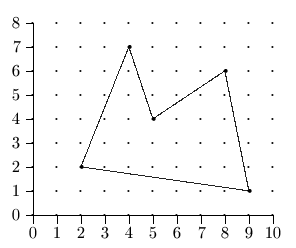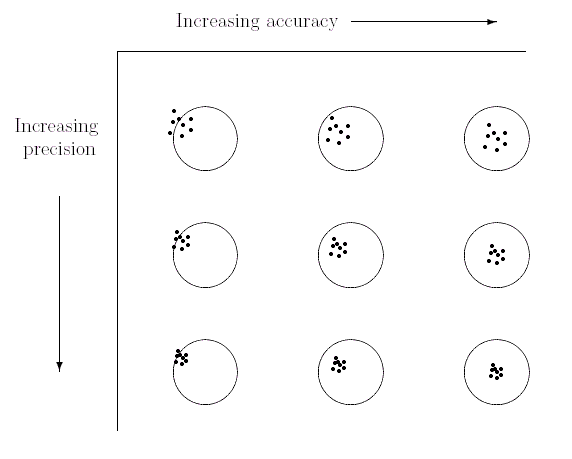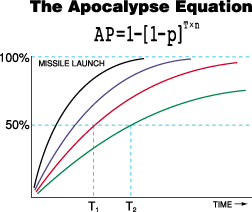
Here you will find an assortment of scientific facts which may be of interest to trivia fans. Most are useless and difficult to work into a conversation, but you never know when someone might ask...
The escape velocity of an object in a circular orbit is 21/2 times the orbital velocity.
Kepler's second law says that under the influence of gravity, an inverse square force, an orbiting body sweeps out equal areas in equal time intervals. However, even if there were no attracting force whatsoever, a body passing another at a constant velocity would still sweep out equal areas in equal time intervals.
In a 1972 paper1 Stephen Hawking proved that it is not possible to bifurcate a black hole -- just in case you were planning to try it.
1 Hawking, S.W., "Black Holes in General Relativity", Comm. in Math. Phys. 25, pp.152-166.
You can (roughly) estimate the maximum size of a raindrop by equating the surface tension 2psr, to the resisting force of the air, 4/3 prwg. For s = 0.06N/m and r = 103kg/m3 this reduces to about 3mm.
If a traffic light changes to yellow as you approach an intersection, you might consider stepping on the gas to speed up. If you go fast enough, the light will appear green. (6.7x107 miles per hour ought to do it.)
Lanchester's Square Law states that the strength of a combat force is proportional to the square of the number of combatants. This law has been applied to various modern battles with remarkable agreement.
Converting 50 grams of matter to energy releases the equivalent of about 1 megaton of TNT.
According to Pick's theorem, the area of any polygon whose vertices are lattice points can be found from the simple equation
Kp= Ip + Bp/2 - 1
where Kp is the total area, Ip is the number of lattice points interior to the polygon, and Bp is the number of lattice points on the boundary of the polygon, including the vertices.

Polygon on Integer Lattice
For the polygon in the figure, there are 21 interior points and 5 boundary points, so the area is Kp = 21 + 5/2 -1 = 22.5 square units.
You've heard about it and talked about it, but do you know what the Richter scale is? The Richter1 earthquake magnitude scale (M) is given by: M = 0.67 log(E) -2.9, where E is the released energy in Joules. Note that a scale reading of 0 is possible, and is roughly equivalent to dropping a bag of groceries.
1There are other Richter scales, but this is the one commonly used in reporting earthquakes.
On a clear summer day, the photon density outside is about 10 million photons per cubic centimeter.
The excess pressure (above atmospheric) inside a water bubble is twice that inside a water droplet of equal size.
The maximum possible voltage gain for a resistor loaded common emitter transistor amplifier is about 38 times the supply voltage.
Here is a function which is 1 for every rational argument, x, and 0 for every irrational argument. It has no derivative anywhere.
![]()
Your Schwartzchild radius is the radius of a sphere with your mass which is so densely packed that the gravitational force at its surface is sufficiently high to prevent light from escaping. That is, it is what your radius would be if you were a black hole. You can calculate it from:
Rs=14.2x10-27 M,
where Rs is in meters and M is in kilograms.
The capacitance of the earth is approximately 710 µF. This value is calculated on the assumption that the earth can be treated as a conducting sphere.
Dung Beetles Navigate by Moonlight -- Headline from BBC, July 2, 2003
Students often confuse the concepts of accuracy and precision. The graphic below highlights the difference between these concepts clearly.

You can easily determine your latitude (in the Northern hemisphere) by pointing to the North Star (Polaris) and estimating the angle between your arm and the horizon.
The Apocalypse Equation is is intended to estimate the probability of a disaster triggered by the launch of nuclear missiles. It is: AP =1 - [1 - p]T×n , where n is the number of nuclear missiles available, p is the probability of launch of each missile and T is the time interval over which the equation is to be evaluated.

43 is the largest non-McNugget number1.
1 Assuming McNuggets can be bought only in quantities of 6, 9, 20, or some combination of multiples of these, a McNugget number is a quantity which can be purchased exactly. Non-McNugget numbers are any other quantity, e.g. 1, 2, 3, 4, 5, 7, 8, 10, 11, 13, etc.
A pole vaulter achieves his height by converting kinetic energy to potential energy. The speed at which the athlete hits the cushioned mat after the vault is about the same as his speed when he left the ground. His maximum vault height is approximately the distance an object would have to fall under the influence of gravity to reach that speed. A slight improvement of this value is possible with modern poles which store energy which is released during the ascent followed by a final thrust upward by the vaulter at the top of the ascent.
When a helium balloon leaks, it performs the remarkable and counter-intuitive feat of losing mass and gaining weight at the same time. This rare combination of properties is duplicated by grazing cows when they liberate methane.
The sun is never directly overhead in any part of the Continental U.S. Hawaii is the only state in which the sun can appear directly overhead, and this occurs near noon during a short period around the summer solstice.
You can estimate the minimum stopping (braking) distance of an automobile using the following equation:
d = v2/(2g)
where 'd' is the stopping distance in feet, 'v' is the initial velocity when the brakes are applied in feet per second, and 'g' is the acceleration due to gravity in feet per second2. This simplified formula assumes that the coefficient of friction between the tires and pavement is close to unity.
According to C.D.H.Williams1, the time required to boil an egg is:
tcooked = lM2/3loge[0.76´(Tegg-Twater)/(Tyolk-Twater)]
l is 27 for a soft-boiled egg and 31 for a hard-boiled egg. The other parameters are explained in the following link:
1 http://newton.ex.ac.uk/teaching/CDHW/egg/#formula
$1.19 is the maximum amount of change you can have and still not be able to provide change for a dollar bill. (3 quarters, 4 dimes and 4 pennies.)
Physics students are told that the curve traced out by a projectile is parabolic. This is a little white lie. The path is actually an arc of an ellipse. The entire ellipse would be traced if the mass of the earth was concentrated at its center and the projectile fired (or ball tossed) on the surface of an imaginary sphere corresponding to the surface of the earth. The discrepancy is explained by the assumption that the acceleration due to gravity, g, is constant at or near the surface of the earth. This is only approximately true.
The front wheel of a bicycle travels farther than the back wheel.
Sound travels faster in fog than in dry air, but light travels slower.
You will never see Venus at midnight in the Continental U.S.
Unless the coefficient of friction between the tires and the ground exceeds unity, the minimum time for a rubber tired vehicle to go from 0 to 60mph is 2.73 seconds.
Homophones are words that sound the same but are spelled differently and have different meanings. Triple homophones involving ordinary English words are fairly common. Examples are: to, two, too and pair, pare, pear. Quadruple homophones are rare. One example is write, right, rite and wright.
Measure the height of water in a container with a chunk of ice floating in it. When the ice melts the height of the water will be
1) higher,
2) the same,
3) lower.
ans: the same.
You can make a decent cartridge brass alloy by melting 5 pre-1982 pennies with 3 post-1982 pennies. So-called yellow brass can be made from 7 pre-1982 pennies and 3 post-1982 pennies. These proportions are estimates based on the fact that early pennies were mostly copper, and later ones were copper-clad zinc.
A rolling disk will become unstable and fall if its velocity is too low. The critical velocity is: (gd/6)1/2, where 'g' is the acceleration due to gravity, and 'd' is the diameter in meters, according to one source, For another discussion see: https://www.physicsforums.com/threads/why-do-wheels-not-topple-over-while-rolling.329795/
Another 'white' lie in physics is that light travels slower in a transparent medium than in a vacuum. This 'fact' is linked with the concept of index of refraction. Actually, according to quantum mechanics, light travels farther, not slower. The interaction of photons and the electrons in the medium causes the photons to follow a zig-zag path which appears to increase the time taken to traverse the media.. Their speed does not change. This correction explains a problem with the slow-down theory: How does light speed up again after it leaves the medium?